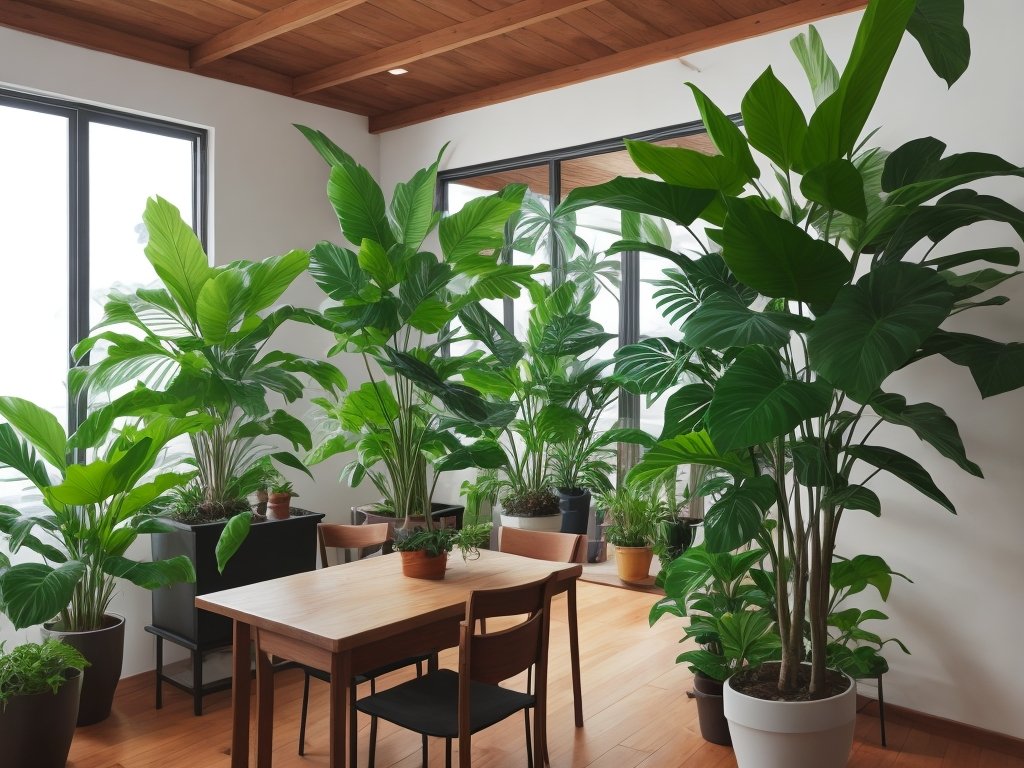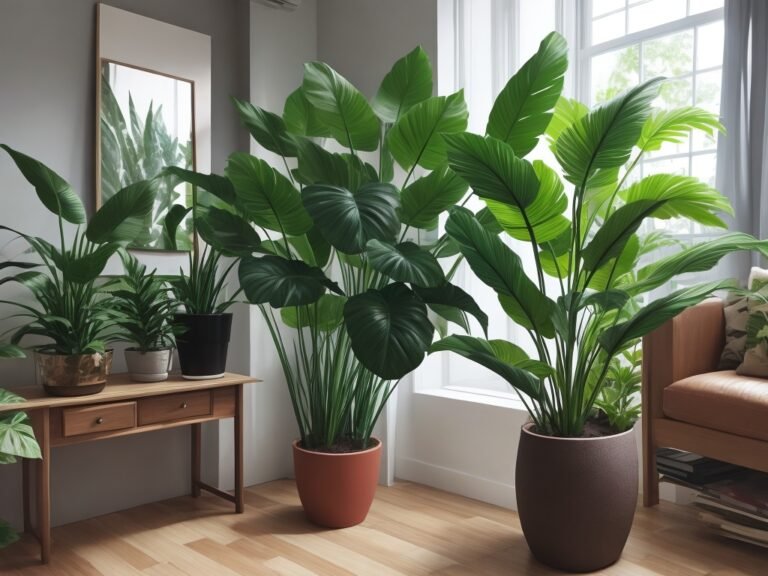Help, My Tropical Plant Is Dying! How To Revive a Neglected Plant
Key Takeaways:
- Assess the plant’s needs: Check for signs of dehydration, nutrient deficiencies, and pest infestations.
- Adjust watering and light levels: Provide adequate water and ensure the plant receives sufficient light based on its species’ requirements.
- Consider repotting and fertilizing: Repot the plant if necessary, using fresh soil and adequate drainage. Use a balanced fertilizer to provide essential nutrients.
- Monitor and provide consistent care: Regularly check the plant’s health, address any issues promptly, and maintain a consistent care routine to help revive and restore its vitality.
Is your tropical plant looking a little worse for wear? Don’t panic, I’ve got you covered! In this article, I’ll walk you through the steps to revive your neglected plant and bring it back to life.
We’ll start by understanding the signs of a neglected plant and the factors that contribute to their decline.
Then, we’ll assess the health of your plant by checking soil moisture, evaluating light conditions, and examining for pests and diseases. From there, I’ll share some basic plant care techniques to get your green friend thriving again.
Ready to give your tropical plant a second chance?
Let’s dive in!
| Issue | Possible Causes | Solutions |
| Lack of water | – Infrequent watering – Soil too dry – Lack of humidity | – Water plant thoroughly – Ensure proper drainage – Increase humidity |
| Too much water | – Overwatering – Poor drainage | – Adjust watering frequency – Improve drainage |
| Lack of sunlight | – Insufficient light – Placement in shady spot | – Move plant to a brighter location – Provide supplemental light |
| Excessive sunlight | – Direct sunlight – Intense heat | – Move plant to a shadier spot – Provide shade or curtains |
| Nutrient deficiency | – Lack of fertilization – Improper soil composition | – Feed plant with appropriate fertilizer – Repot with nutrient-rich soil |
| Pests | – Insect infestation – Spider mites – Fungal or bacterial diseases | – Identify and treat pests – Wipe leaves with soapy water – Remove infected parts |
Understanding the Signs of a Neglected Plant
Is your tropical plant looking sad and wilted? Learn how to recognize the signs of a neglected plant.
Why is my tropical plant dying?
Your tropical plant may be dying due to a variety of reasons.
Inadequate light, incorrect watering habits, nutrient deficiencies, pest infestations, or diseases can all contribute to its decline.
Assessing your plant’s health and addressing these issues promptly can help revive it.

Recognizing the common symptoms of a neglected plant
Recognizing the common symptoms of a neglected plant is essential for understanding its health issues.
Look out for wilting or drooping leaves, yellowing or browning leaves, stunted growth, and dry or compacted soil.
Pest infestations, such as webs or holes on leaves, can also indicate neglect.
Factors that contribute to the decline of tropical plants
Tropical plants can decline due to several factors.
These may include inadequate watering, improper light conditions, pest infestations, nutrient deficiencies, and poor soil health.
Assessing these factors and taking appropriate actions can help revive your neglected plant.

Assessing the Health of Your Neglected Plant
To assess the health of your neglected plant, you’ll need to check the soil moisture and drainage, evaluate the light conditions, and examine for any pest or disease infestations.
Checking the soil moisture and drainage
To check the soil moisture, stick your finger about an inch into the soil.
If it feels dry, it’s time to water.
If it feels wet or damp, hold off on watering.
As for drainage, make sure your plant’s pot has drainage holes to prevent water from sitting in the roots.
Evaluating the light conditions
To evaluate the light conditions for your neglected tropical plant, observe the plant’s behavior. Is it getting enough light?
Look for signs of inadequate light, such as leggy growth, pale leaves, or lack of flowering.
On the other hand, if the leaves are yellowing or brown, it might be getting too much light. Adjust the plant’s location accordingly to provide the right amount of light.

Examining the pest and disease infestations
To examine pest and disease infestations in your neglected plant, carefully inspect the leaves, stems, and soil. Look for any signs of insects, such as aphids or mealybugs, as well as any abnormal discoloration, spots, or holes on the plant.
Check the soil for fungal growth or any signs of root rot.
It’s important to identify the specific pests or diseases affecting your plant to determine the best treatment plan.
Basic Plant Care Techniques for Reviving Neglected Plants
To revive neglected plants, adjust your watering habits, provide appropriate lighting, and prune and trim for new growth.
Adjusting watering habits
To adjust your watering habits for a neglected plant, make sure to thoroughly water the soil until it drains out of the bottom of the pot. Allow the top inch of soil to dry before watering again.
Avoid overwatering, as this can lead to root rot.
Regularly check the moisture level of the soil by sticking your finger into it. And remember, each plant has different watering needs, so observe your plant’s response to determine the best watering schedule.
Providing appropriate lighting
To provide appropriate lighting for your neglected tropical plant, it’s important to understand its light requirements.
Place your plant in an area that receives the right amount of light, whether it’s bright indirect light, partial shade, or full sun.
If needed, you can also supplement with artificial grow lights.
Avoid placing your plant in direct sunlight, as it can cause sunburn and damage.
Regularly assess the light conditions and adjust as necessary to promote healthy growth.
Pruning and trimming to encourage new growth
Pruning and trimming are essential for encouraging new growth in neglected plants.
Here’s how you can do it:
- Remove dead or damaged branches: Cut back any dead or broken branches to promote new growth.
- Trim overgrown areas: Prune back excessive growth to allow light and air circulation, stimulating new shoots.
- Pinch off spent flowers: Removing faded flowers redirects energy to promote new blooms or foliage.
- Cut back leggy stems: To encourage bushier growth, trim long, leggy stems by one-third or half their length.
- Prune diseased or pest-infested parts: Removing infected areas prevents further spread and encourages healthier growth.
Remember, always use clean, sharp tools and prune during the plant’s dormant period for best results.
Restoring Nutrients and Soil Health
To revive your neglected tropical plant, focus on restoring nutrients and improving soil health.
This can be done by addressing nutrient deficiencies, choosing the right fertilizer, and implementing soil amendment techniques.
Nutrient deficiencies and their impact on plant health
Nutrient deficiencies can have a significant impact on plant health.
Lack of essential nutrients can lead to stunted growth, yellowing leaves, and reduced flowering or fruit production.
Each nutrient plays a specific role in plant development, and deficiencies can disrupt vital processes like photosynthesis and nutrient uptake.
It’s crucial to identify and address nutrient deficiencies to promote healthy growth and ensure the overall well-being of your tropical plant.
Choosing the right fertilizer for your tropical plant
Choosing the right fertilizer for your tropical plant is important for its health and growth. Look for a fertilizer with a balanced ratio of nutrients, such as a 10-10-10 or 20-20-20 blend.
Organic options like compost or worm castings are also beneficial.
Consider the specific needs of your plant, such as whether it prefers acidic or alkaline soil. And always follow the instructions on the fertilizer packaging for proper application.
Soil amendment techniques to improve fertility
To improve soil fertility, you can use various soil amendment techniques.
These include:
- Adding organic matter like compost or aged manure to enrich the soil with nutrients and improve its structure.
- Applying lime to adjust soil pH if it is too acidic or sulfur if it is too alkaline.
- Using cover crops or green manures to add organic matter, nitrogen, and other nutrients to the soil.
- Mulching with organic materials, such as straw or wood chips, to reduce weed growth, retain moisture, and provide nutrients as they break down.
- Rotating crops to prevent nutrient depletion and minimize the risk of pests and diseases.
Remember, regular soil testing is essential to determine specific nutrient deficiencies and adjust amendment techniques accordingly.
Dealing with Pest and Disease Issues
Identifying and addressing common pests and diseases is essential for reviving a neglected tropical plant.
Identifying common pests affecting tropical plants
Identifying common pests affecting tropical plants is essential for effective pest control. Some common pests include aphids, whiteflies, spider mites, mealybugs, and scale insects.
Look for signs like distorted leaves, sticky residue, yellowing or wilting leaves, and small dots on leaves.
Regular monitoring helps catch infestations early on.
Natural remedies for pest control
Natural remedies for pest control include:
- Introducing beneficial insects, like ladybugs and lacewings, to eat harmful pests.
- Using neem oil or insecticidal soap to deter insects.
- Sprinkling diatomaceous earth or crushed eggshells to deter crawling pests.
- Planting herbs like basil, mint, and rosemary, which repel pests.
- Creating companion planting combinations that naturally deter pests, such as marigolds near vegetables.
- Using homemade vinegar or garlic sprays to repel insects.
- Regularly cleaning and inspecting plants for signs of pests to catch infestations early.
Recognizing and treating common plant diseases
Recognizing and treating common plant diseases is essential for the health of your tropical plants. Look out for symptoms like spots, discoloration, wilting, and distorted growth.
Treat fungal diseases with fungicides, bacterial diseases with copper-based sprays, and viral diseases by removing infected plants.
Proper sanitation and good plant care practices can help prevent disease outbreaks.
Troubleshooting Common Problems
Having trouble with your tropical plant?
Let’s troubleshoot common problems together!
Yellowing leaves: causes and solutions
Yellowing leaves in tropical plants can be caused by various factors such as nutrient deficiencies, overwatering, and improper light conditions. To address this issue, you can start by adjusting your watering habits, providing appropriate lighting, and ensuring proper nutrient levels.
Also, it’s important to check for any pests or diseases that may be affecting your plant and taking appropriate measures to treat them.
Wilting or drooping leaves: causes and remedies
Wilting or drooping leaves in tropical plants can be caused by several factors, including underwatering, overwatering, improper lighting, and pest infestations.
To remedy the issue, check the soil moisture and adjust watering habits accordingly.
Ensure the plant receives appropriate light conditions and consider pruning to encourage new growth.
Address any pest or disease issues promptly.
Root rot and overwatering: prevention and recovery
To prevent root rot and overwatering, make sure to check the soil moisture before watering. Only water your tropical plant when the top inch of soil feels dry to the touch.
Improve drainage by using well-draining soil and pots with drainage holes.
If your plant is already suffering from root rot, remove any affected roots, repot it in fresh soil, and adjust your watering habits. Allow the soil to dry out between waterings to give the roots a chance to recover.
Creating a Regular Care Routine for Your Tropical Plant
To care for your tropical plant, establish a watering schedule and provide consistent light and temperature conditions. Don’t forget to regularly inspect for pests and diseases.
Establishing a watering schedule
Establishing a watering schedule for your tropical plant is essential for its health.
A good rule of thumb is to water when the top inch of soil feels dry to the touch.
Remember to water thoroughly, allowing the excess water to drain out.
Avoid overwatering, as this can lead to root rot.
A consistent watering routine will help your plant thrive.
Providing consistent light and temperature conditions
To provide consistent light and temperature conditions for your tropical plant, place it in a location with bright, indirect sunlight. Avoid placing it near drafty windows or heating vents, as sudden changes in temperature can stress the plant.
Maintain a temperature range between 65 to 85 degrees Fahrenheit (18-29 degrees Celsius).
Using curtains or blinds can help regulate the amount of light your plant receives. Avoid exposing your plant to extreme temperatures or prolonged periods of darkness, as this can harm its health.
Regularly inspecting for pests and diseases
Regularly inspecting your tropical plant for pests and diseases is crucial for its health.
Look for signs of insect infestation, such as webbing, holes in leaves, or sticky residue.
Check for abnormal leaf color, spots, or mold growth, which could indicate disease.
Prompt detection allows for effective treatment and prevents further damage.
Frequently Asked Questions
How long does it take for a neglected plant to recover?
Reviving a neglected plant depends on its specific condition and the steps taken to care for it.
It can take anywhere from a few weeks to several months for a neglected plant to fully recover.
Consistent care and attention, such as adjusting watering habits, providing appropriate lighting, and ensuring soil health, are key to helping the plant bounce back.
Patience is important, as each plant’s recovery time can vary.
Can I save an overwatered plant?
Yes, you can save an overwatered plant! Start by removing any excess water from the pot and allowing the soil to dry out. Adjust your watering habits and provide proper drainage.
Prune away any damaged or rotting roots, and consider repotting in well-draining soil.
With time and care, your plant can recover.
Is repotting necessary to revive a neglected plant?
Repotting is not always necessary to revive a neglected plant. It depends on the root health, soil condition, and pot size.
If the roots are healthy and the pot is spacious enough, you can focus on other care techniques.
However, if the roots are severely overcrowded or the soil is compacted and lacking nutrients, repotting can help rejuvenate the plant. Consider repotting if necessary, but prioritize addressing other factors impacting the plant’s health.
Final Verdict
Reviving a neglected tropical plant requires understanding the signs of neglect, assessing its health, implementing basic care techniques, restoring nutrients and soil health, addressing pest and disease issues, troubleshooting common problems, and establishing a regular care routine. By adjusting watering habits, providing appropriate lighting, and pruning to encourage new growth, you can breathe new life into your dying plant.
Additionally, choosing the right fertilizer, employing natural pest control remedies, and treating common plant diseases will further aid in its recovery.
With patience and consistent care, your neglected plant can thrive once again, adding beauty and serenity to your space.







